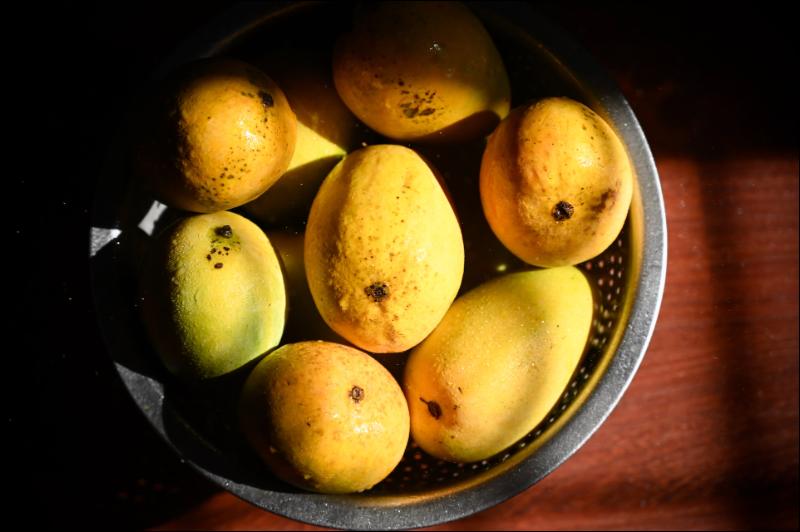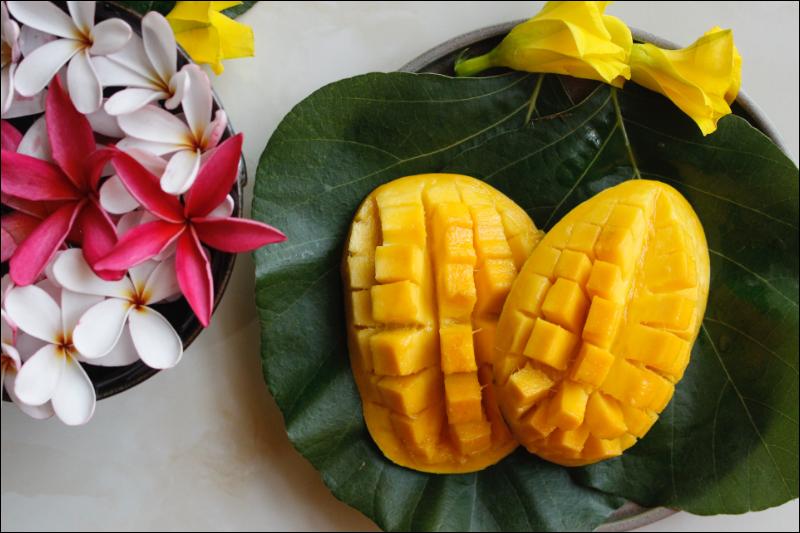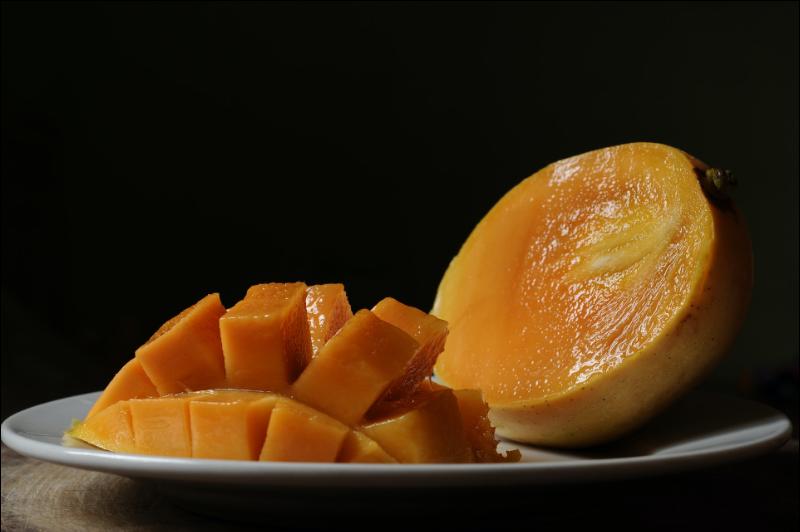Mangos or Mangoes?
Both “mangos” and “mangoes” are correct spellings.
The plural of mango can be spelled either way. The Oxford English Dictionary (OED) lists both spellings as acceptable. The OED also notes that the spelling “mangoes” is more common in British English, while the spelling “mangos” is more common in American English.
Ultimately, the choice of spelling is a matter of personal preference. There is no right or wrong answer.
Now that we got the semantics out of the way, let’s learn more about these fruit!
What are mangos (or mangoes)?
Yes, let’s get that out of the way too. Just in case! Hey, you never know.

A mango is a tropical fruit known for its sweet and juicy flavor. It is considered the “king of fruits” due to its delicious taste and rich nutritional profile. Mangoes have a distinctive oval or elongated shape and are typically yellow, orange, or red in color when ripe. The fruit has a smooth, thin skin and a large, flat seed in the center.
How do you eat it? Raw or Cooked?
Mangoes can be eaten both raw and ripe, depending on what you like and in some cases cook it – add it to dishes. Here are some common ways to enjoy mangoes:

- Eating it raw:
- Ripe mangoes can be eaten raw by simply peeling off the skin and slicing the fruit. The flesh is juicy and sweet, and you can eat it directly or cut it into cubes.
- It’s common to enjoy ripe mangoes as a refreshing snack or dessert during the summer season.
- Or in a variety of dishes, drinks or whatever:
- Mangoes are widely used in various culinary creations. They can be added to fruit salads, smoothies, and juices for a burst of flavor.
- Mangoes are also used in ice creams, sorbets, and milkshakes to add a creamy and fruity element.
- In savory dishes, green or unripe mangoes are used to make tangy and spicy chutneys, pickles, or as a souring agent in curries, salads, and salsas.
- Cooking or processing:
- While ripe mangoes are typically eaten fresh, some recipes may involve cooking or processing the fruit. For example, mangoes can be used to make mango puree, which can be used as a base for sauces, desserts, or baked goods.
- In some cuisines, mangoes are used in cooked dishes like curries or stews, where the fruit adds a touch of sweetness and enhances the overall flavor.
The taste and texture of mangoes vary depending on the variety and ripeness. Ripe mangoes are soft, fragrant, and sweet, while green or unripe mangoes are firm, tangy, and slightly sour. Both ripe and unripe mangoes have their own uses and can be enjoyed in different ways.
Where did Mangoes come from?
The mango, scientifically known as Mangifera indica, is a tropical fruit that originates from the Indian subcontinent. It is believed to have been cultivated in South Asia for over 4,000 years.
The fruit’s popularity and cultivation spread throughout the centuries, facilitated by trade routes and human migration.
Where do mangoes grow?
The mango tree is well-adapted to warm, tropical climates and is now grown in many parts of the world, including Southeast Asia, Africa, the Caribbean, and Central and South America.
Mango trees require a warm climate with temperatures between 25 to 35 degrees Celsius (77 to 95 degrees Fahrenheit) to thrive.
They prefer well-drained soil and are often found in regions with distinct wet and dry seasons, as this helps promote flowering and fruiting.
The fruit itself is known for its sweet, juicy flesh and a wide range of vibrant colors, including shades of yellow, orange, and red.
Today, mangoes are widely cultivated in countries such as India, Pakistan, Bangladesh, Mexico, Brazil, Thailand, Indonesia, and the Philippines. Each region has its own varieties, flavors, and characteristics, making mangoes a beloved fruit worldwide.
How did mangoes spread all over?
The spread of mangoes to South America, Mexico, and other parts of the world can be attributed to various factors, including historical trade routes, human migration, and intentional cultivation.
While specific routes or data might be challenging to pinpoint, here are some general accounts of how mangoes made their way to different regions:
- Colonial Exploration and Trade: During the era of European colonial exploration, sailors and traders traveled across the globe, establishing trade routes between continents. It is believed that Portuguese explorers played a significant role in introducing mangoes to Brazil in the 16th century. Similarly, Spanish colonizers may have introduced mango cultivation to Mexico and other parts of Latin America.
- Cultural Exchange and Migration: Human migration has played a crucial role in spreading agricultural products across different regions. It is likely that mangoes were carried by migrants, either intentionally or unintentionally, as they traveled to new lands. For example, Indian indentured laborers brought mangoes to the Caribbean, including countries like Jamaica and Trinidad, during the 19th century.
- Botanical Exchanges: The exchange of plant specimens and seeds between botanists, horticulturists, and plant enthusiasts has also contributed to the spread of mangoes. As scientific exploration and botanical gardens grew in popularity, mango trees were transported and cultivated in new locations. The Royal Botanic Gardens in Kew, England, played a significant role in this exchange, introducing mangoes to various parts of the world.
The above information is based on historical records and plausible theories.
Earliest known usage of mangoes

The earliest known mention of mangoes in literature dates back to ancient India.
The Sanskrit text called the “Rigveda,” composed between 1500 and 1200 BCE, contains references to mangoes.
The Rigveda describes mangoes as one of the most delightful fruits, highlighting their juicy pulp and sweet flavor.
The Sanskrit text called the “Rigveda,” composed between 1500 and 1200 BCE, contains references to mangoes.
In different areas of the world, mangoes have been mentioned in various ancient texts:
- India:
- Rigveda (1500-1200 BCE): The Rigveda, one of the oldest religious texts in ancient Indian literature, contains references to mangoes. It describes mangoes as delightful fruits with juicy pulp and a sweet taste.
- Ramayana (composed around 500 BCE): The Ramayana, an ancient Indian epic, mentions mangoes in several instances. It describes mango orchards, the allure of their fragrance, and depicts mangoes as a symbol of abundance and prosperity.
- Southeast Asia:
- The ancient civilizations of Southeast Asia, such as the Khmer and Thai kingdoms, also revered mangoes. Ramakien (Thai adaptation of Ramayana): The Ramakien, the Thai version of the Ramayana, incorporates mangoes into its narrative. Mangoes are depicted as part of the cultural context, scenery, and symbolism within the epic.
- Persia (ancient Iran):
- Persian Poetry: Persian poets have often referenced mangoes in their works. Notable among them is Omar Khayyam (1048-1131 CE), a renowned Persian poet, who mentions mangoes in his poetry. He describes the beauty of mangoes and their desirability.
- Arab World:
- Arabic Poetry: Mangoes are mentioned in Arabic poetry, reflecting their popularity and appeal. Al-Mutanabbi (915-965 CE), a famous Arab poet, praised mangoes in his poetry for their lusciousness and fragrance.
- Europe:
- The Crusaders returning from the Middle East brought back tales of exotic fruits, including mangoes, to Europe. Marco Polo’s Travels (13th century): The Italian explorer Marco Polo, in his travel accounts, mentioned mangoes during his journeys to India and Southeast Asia. He described mangoes as delicious fruits with a unique taste and vibrant colors, introducing Europeans to this exotic fruit.
These are some of the earliest known mentions of mangoes in different regions of the world. The fruit’s popularity and spread throughout history can be attributed to its delicious taste, rich cultural significance, and the efforts of traders, explorers, and cultivators who helped introduce mangoes to various parts of the globe.
The journey of mangoes from the Indian subcontinent to the Caribbean before the arrival of European explorers
How did mangoes go to The Caribbean islands?
The journey of mangoes from the Indian subcontinent to the Caribbean before the arrival of European explorers is a fascinating example of how plants and their cultivation spread through human migration and trade networks.
It is believed that mangoes were introduced to the Caribbean by early Austronesian seafarers who were skilled navigators and traders. These seafaring communities, originating from Southeast Asia, had established extensive trade routes across the Indian Ocean, connecting various regions including the Indian subcontinent.
As these Austronesian sailors ventured farther, they reached the Indian subcontinent and encountered the mango tree, recognizing its delectable fruit and its potential value for trade and cultivation. The sailors likely carried mango seeds or seedlings on their voyages, deliberately or unintentionally, as provisions or as gifts exchanged during their trade activities.
Over time, these seafarers navigated their way to the islands of the Caribbean, including present-day Jamaica, Cuba, and Hispaniola (Haiti and the Dominican Republic). It is believed that they brought mango seeds or seedlings with them and planted them in the fertile soils of the Caribbean islands.
Once established, the mango trees thrived in the favorable tropical climate of the Caribbean. They adapted to the local environment and gradually spread throughout the region, establishing themselves as a valuable fruit crop. The fruit’s delicious taste, vibrant colors, and versatility in culinary applications made it popular among the local communities.
How do we know this?
There is evidence to suggest that mangoes were present in the Caribbean prior to European contact.
Historical records and accounts from early explorers and travelers, such as Christopher Columbus and Gonzalo Fernández de Oviedo, mention the existence of mangoes in the Caribbean during their expeditions in the late 15th and early 16th centuries. These accounts indicate that mangoes were already being cultivated and consumed by the indigenous populations of the Caribbean islands.
Additionally, linguistic connections between languages spoken in the Indian subcontinent and certain Caribbean islands further support the hypothesis of pre-Columbian mango presence. The similarity in the names of mangoes across different languages, such as “manga” in Arawak (an indigenous language of the Caribbean) and “mangai” in an Indian languages, suggests an ancient association between the fruit and the region.
The word “mango” comes from the Tamil word “mangai”. In other south Indian languages, mango is called:
- Malayalam: മാമ്പഴം (maṃpazham)
- Tamil: மாங்காய் (maṅkkāy or mangai)
- Telugu: మామిడి (māmidi)
The English word “mango” is thought to have originated from the Portuguese word “manga”, which in turn is derived from the Malay word “mangga”. The Malay word is thought to have originated from the Tamil word “mangai”.
Archaeological evidence, though limited, has also uncovered mango seeds and pollen in pre-Columbian archaeological sites in the Caribbean, indicating the presence of mangoes before European arrival.
Fascinating, is it not?
Top dozen types of Mangoes in India
This is going to be a very controversial list, but blame google’s searches for this below list. If you don’t see your favorite mango variety on this list, let us know what it’s called and maybe send us a basket of those mangoes so we can do our own research :).
India is known for its diverse varieties of mangoes, each with its unique characteristics and flavors. Here are a dozen popular mango varieties from different parts of the country:
Alphonso (Hapus)
Originating from Maharashtra and Gujarat, Alphonso is often considered the king of mangoes. It has a rich, creamy texture, and a sweet, aromatic flavor.
Kesar
Also known as Gir Kesar, this variety is primarily grown in Gujarat. Kesar mangoes are small to medium-sized with a golden-yellow color, a distinct aroma, and a sweet-tangy taste.
Langra
Hailing from Uttar Pradesh, Langra mangoes are medium-sized with a greenish-yellow skin. They are known for their fiberless flesh, juicy texture, and sweet taste.
Dasheri
Native to Uttar Pradesh, Dasheri mangoes are medium-sized with a greenish-yellow skin and a sweet, aromatic flavor. They have a fiberless and juicy pulp.
TotapurI
Widely cultivated in the southern states of Andhra Pradesh, Karnataka, and Tamil Nadu, Totapuri mangoes are large-sized with a distinctive beak-like shape. They have a tangy flavor and are often used for making pickles and chutneys. It is a popular choice for eating fresh or making juice.
Badami
Grown in Karnataka, Badami mangoes are similar to Alphonso mangoes in terms of appearance and taste. They have a sweet flavor and a smooth, buttery texture. (see here)
Neelam
Popular in Andhra Pradesh, Telangana, and Tamil Nadu, Neelam mangoes are medium to large-sized with a yellow skin and a sweet, juicy pulp and long shelf life. They are often used for making mango desserts and beverages. (see here)
Himsagar
Primarily grown in West Bengal, Himsagar mangoes are known for their pleasant aroma, fiberless pulp, and sweet taste. They have a yellow skin with green patches (see here)
Banganapalli (Benishan)
Cultivated in Andhra Pradesh and Telangana, Banganapalli mangoes are large-sized with a golden-yellow skin. They are sweet, fiberless, and have a unique flavor. (see here)
Malda
Hailing from the Malda district in West Bengal, these mangoes are small to medium-sized with a greenish-yellow skin and a sweet, juicy pulp. They are often used for making mango-based desserts.
Mulgoba
Native to Tamil Nadu, Mulgoba mangoes are medium-sized with a greenish-yellow skin and a rich, sweet flavor. They are known for their excellent taste and aroma.
Sindhu
Grown in Karnataka and Andhra Pradesh, Sindhu mangoes are medium-sized with a yellowish-green skin. They have a tangy-sweet taste and are commonly used for making mango-based dishes and beverages.
It’s important to note that mango varieties can vary within regions due to factors like climate, soil conditions, and local cultivation practices. Each region may have its own local favorites and specialty mango varieties.
How do you eat a Mango?
Again this is a controversial topic! Everyone has an opinion on this. So instead of going into all of those here is a video and you can see for yourself.
